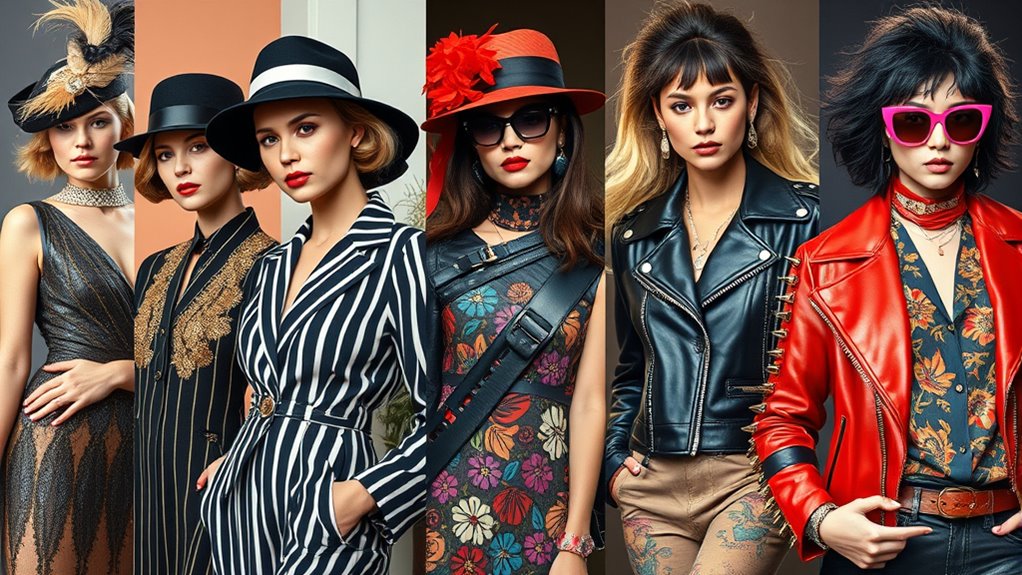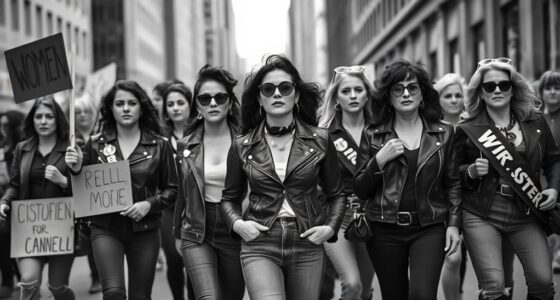Fashion across the decades reflects the culture, society, and technology of each era. From the lively, rebellious styles of the 1920s jazz age to the practical, resilient looks during WWII, each period shows how people express themselves amid social changes. The 1960s and 1970s brought youth activism and freedom, while the 1980s emphasized power dressing. Today’s fashion mixes diversity, sustainability, and innovation—discover how history shapes your style evolution as you explore each decade’s unique story.
Key Takeaways
- Cultural shifts like the flappers’ independence in the 1920s and post-war optimism in the 1950s directly influenced fashion styles and societal ideals.
- Youth movements and activism in the 1960s and 1970s used fashion as a form of self-expression, resistance, and cultural identity.
- Economic hardships and wartime shortages during the Great Depression and WWII fostered practical, resourceful clothing reflecting resilience.
- Technological advancements and social media from the 1990s onward accelerated trend sharing, emphasizing diversity, innovation, and cultural influences.
- Growing awareness of sustainability and cultural diversity increasingly shaped modern fashion, reflecting societal values and global interconnectedness.
The Roaring Twenties: Flappers and the Jazz Age

Have you ever wondered how the 1920s revolutionized fashion? During this vibrant decade, Art Deco influenced every aspect of style, emphasizing bold geometric patterns and luxurious details. Flapper fashion embodied the era’s spirit, with women embracing shorter hemlines, dropped waistlines, and fringe embellishments. You’d see women daring to wear sleeveless dresses and bobbed hair, symbolizing newfound independence. Jazz music and nightlife fueled this energetic look, reflecting a break from traditional norms. The fashion became more daring, lively, and expressive, capturing the essence of freedom and modernity. The decade’s styles weren’t just about clothing—they represented a cultural shift toward self-expression and breaking conventions, making the 1920s a truly transformative period in fashion history. Incorporating vintage decor elements like antique jewelry and accessories further accentuated this era’s distinctive aesthetic. Additionally, the widespread adoption of fashion trends that emphasized individualism helped define the decade’s unique style identity. Moreover, the rise of remote hackathons and digital collaboration tools during this era showcased how innovation and creativity could transcend geographical boundaries, paralleling the era’s spirit of breaking norms.
The Great Depression and World War II: Resilience in Fashion
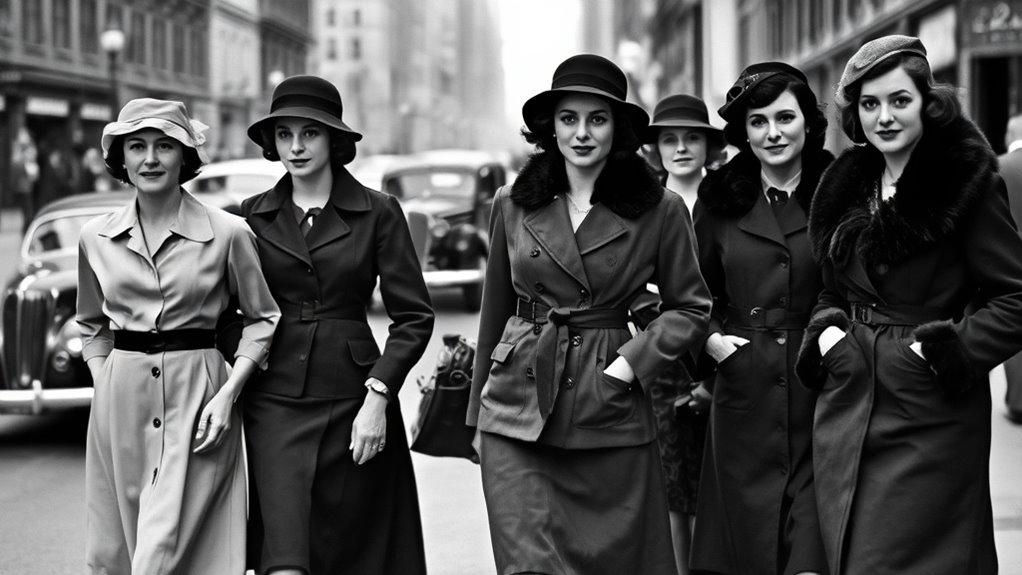
During the Great Depression and World War II, fashion became a proof of resilience and practicality, as economic hardships and wartime shortages forced you to adapt your style. You turned to vintage textiles, repurposing old garments and making do with limited resources. Wartime utility became essential, leading to simple, functional designs that prioritized durability over decoration. Clothing was often plain, with minimal embellishments, reflecting the need for affordability and practicality. You learned to mend and reuse clothing, extending the life of garments. Utility and resourcefulness defined this era’s fashion, demonstrating that style could survive adversity. Despite restrictions, you found ways to express individuality through clever tailoring and subtle details, proving that resilience in fashion was as crucial as in life.
Post-War Prosperity and the 1950s: The Rise of Suburbia and Glamour
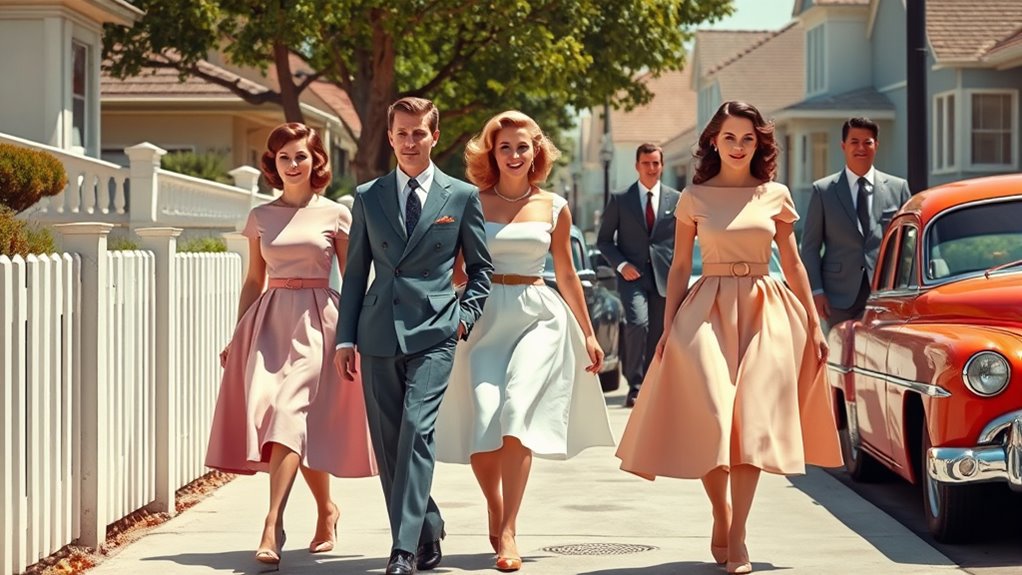
As the post-war economy flourished, the 1950s ushered in a new era of optimism and growth, shaping the rise of suburbia and glamour. You notice how suburban elegance becomes a symbol of success, with women wearing polished, tailored dresses that highlight their femininity. 1950s couture emphasizes hourglass silhouettes, full skirts, and fitted waists, reflecting the decade’s obsession with glamour and sophistication. Fashion becomes more accessible, yet still glamorous, as department stores promote ready-to-wear styles that emphasize neatness and charm. You see how this era’s fashion mirrors the cultural shift toward stability and prosperity, with an emphasis on appearance and social status. The stylish, polished look of the 1950s encapsulates the optimism and newfound confidence of post-war America. Additionally, the era’s fashion trends were influenced by cybersecurity vulnerabilities, which impacted how global brands marketed and distributed their styles through emerging retail channels.
The 1960s Counterculture: Revolution, Mod Style, and Youth Expression
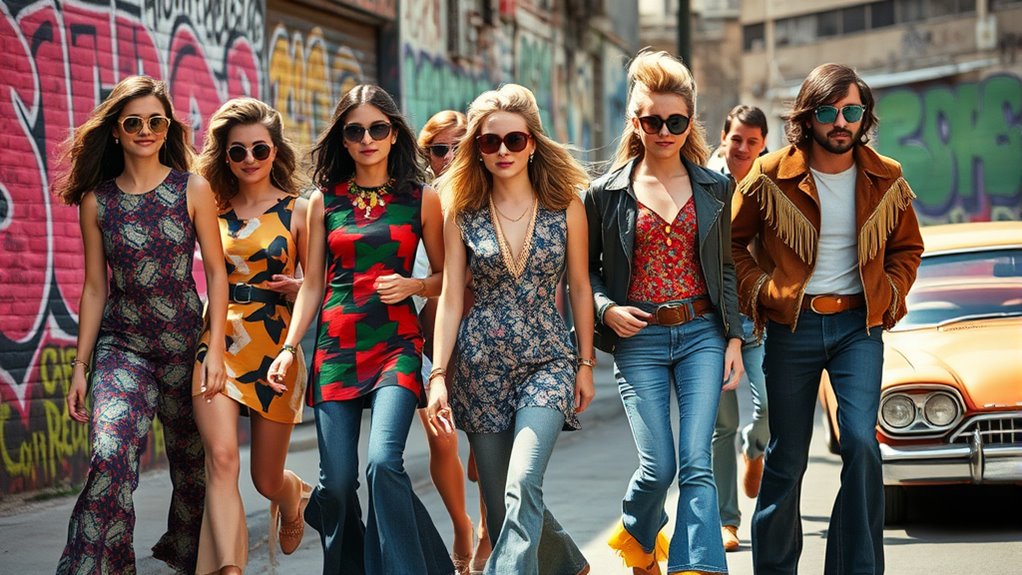
The 1960s erupted with a wave of cultural upheaval that challenged traditional norms and embraced individuality. You see, this era’s fashion became a powerful form of youth expression and fashion activism. Bohemian influences swept in, inspiring free-flowing fabrics, colorful patterns, and artisanal details that rejected mainstream conformity. Mod style also took center stage, with sleek lines, geometric shapes, and bold colors reflecting a modern, youthful attitude. As you wear these styles, you’re participating in a movement that values personal freedom and social change. Fashion became more than just clothing; it was a statement against the establishment, a way to express your beliefs and identity. This decade transformed fashion into a tool for revolution, making personal style a symbol of cultural resistance.
The 1970s: Disco, Punk, and the Breaking of Fashion Norms
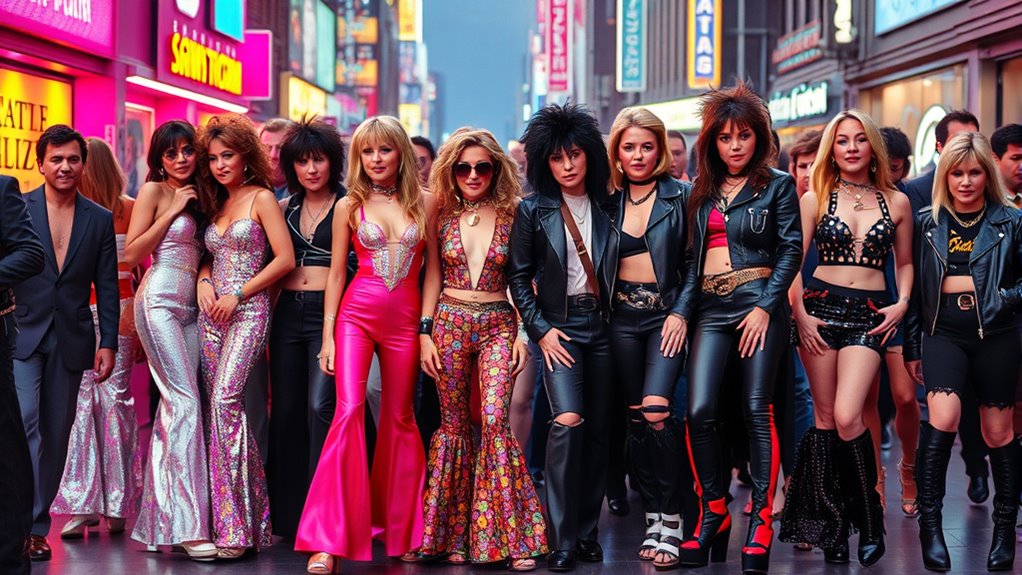
In the 1970s, fashion takes bold turns with disco glam and glitter that let you shine on the dance floor. At the same time, punk rebels challenge conventions with edgy, DIY styles that scream individuality. These movements push boundaries and reshape what it means to express yourself through clothing. Additionally, the era’s fashion was influenced by seasonal variations, which encouraged diverse styles suited for both warm nights and cooler days. The use of fashion trends during this period reflected the broader cultural shifts and the desire for self-expression across different social groups. Moreover, the emphasis on color schemes contributed to the vibrant and eclectic aesthetic characteristic of the decade.
Disco Glam and Glitter
Disco glam and glitter exploded onto the fashion scene in the 1970s, transforming nightlife styles into dazzling displays of individuality. As you stepped into clubs, neon lights reflected off shimmering fabrics, making every movement glow. Glitter balls spun overhead, casting shimmering spots of light that amplified the extravagance of your outfit. You embraced bold, form-fitting jumpsuits, bell-bottoms, and metallic fabrics that screamed for attention. Sequins and reflective materials became staples, turning the dance floor into a runway of self-expression. This era celebrated excess and fun, encouraging you to stand out with vibrant colors and shiny textures. Disco fashion was all about feeling confident and unrestrained, using glitter and neon as symbols of freedom and the desire to shine brightly in the chaos of the night.
Punk Rebellion Styles
Amid the vibrant chaos of the 1970s, punk rebellion emerged as a fierce alternative to disco glamour, challenging traditional fashion norms with its bold, rebellious style. You embrace DIY fashion, customizing ripped jeans, safety pins, and torn T-shirts to create a raw, authentic look. Punk street style is all about making a statement—think leather jackets, studded accessories, and messy, spiked hair. This movement rejects polished perfection, instead celebrating individuality and defiance. You’re encouraged to experiment and break rules, turning everyday items into tools of self-expression. Punk’s influence pushes you to challenge the status quo, blending practicality with anarchy to carve out a unique identity on the streets. It’s about rebellion, attitude, and forging your own fashion path.
The 1980s: Power Dressing and Global Influences

The 1980s transformed fashion with bold power dressing and a surge of global influences that reshaped style standards. You saw shoulder pads, tailored suits, and bright colors dominating the scene, reflecting confidence and authority. During this era, the streetwear evolution began to take root, blending casual and professional styles that challenged traditional norms. Key trends included:
- Power suits with exaggerated shoulders for commanding presence
- Bright, neon colors and oversized silhouettes for bold self-expression
- The rise of eco conscious fashion, emphasizing sustainable fabrics amid growing awareness
- Global influences bringing vibrant patterns and styles from different cultures into mainstream fashion
Additionally, the increased use of sustainable fabrics became more prominent as designers responded to increasing environmental concerns, marking an important shift in fashion priorities. The era also saw an increased appreciation for cultural diversity in fashion, as designers drew inspiration from various regions around the world. This period marked a significant step towards the integration of AI security principles in fashion, ensuring the protection of intellectual property and digital assets. These shifts made fashion more diverse, expressive, and conscious—setting the stage for future innovations.
The 1990s: Grunge, Minimalism, and Technology’s Impact

In the 1990s, you notice how grunge fashion embodies a rebellious, laid-back attitude with flannel shirts and ripped jeans. Meanwhile, technology begins to influence styles, from wearable gadgets to digital-inspired prints. These shifts shape a decade that balances raw self-expression with the dawn of digital innovation.
Grunge’s Rebel Aesthetic
Have you ever wondered how the 1990s rebellious fashion made its mark? The grunge scene embraced a DIY ethos, encouraging you to create a look that was authentic and anti-establishment. The flannel aesthetic became a symbol of rebellion, with oversized shirts layered over band tees and ripped jeans. To capture this vibe, focus on these key elements:
- Mix and match thrifted clothing for a rugged, unpolished look
- Embrace the flannel aesthetic as a core piece
- Add distressed or ripped denim for a worn-in feel
- Keep accessories minimal, favoring simplicity over flash
This style was all about rejecting polished trends, instead celebrating individuality through imperfect, comfortable clothing. The grunge aesthetic became a badge of nonconformity, shaping a unique fashion statement that still influences today.
Tech Influence Emerges
As the 1990s unfolded, technology began transforming fashion in ways that reflected the era’s evolving culture. Virtual runways emerged, allowing designers to showcase their collections digitally and reach wider audiences instantly. Wearable tech started to gain attention, with gadgets like pagers, early cell phones, and accessories influencing style choices. The decade’s minimalism was complemented by sleek, functional designs inspired by technological innovation. You could see this influence in the rise of grunge’s casual, effortless look combined with futuristic touches. technological innovation also shaped fashion events, making them more accessible through televised shows and online platforms. Additionally, digital platforms enabled a broader audience to engage with and influence style trends, democratizing fashion like never before. Overall, the 1990s marked a pivotal shift where fashion and technology intertwined, setting the stage for the digital and wearable tech trends that continue to evolve today.
The 2000s and Beyond: Digital Age, Fast Fashion, and Cultural Diversity

How has the digital age transformed fashion since the 2000s? Social media revolutionized how you discover and share styles, making trends spread instantly. You now see 1) fast fashion brands rapidly releasing new collections based on viral online trends, fueling quick turnovers. 2) Influencers and online communities shape your wardrobe choices more than ever. 3) Cultural diversity becomes more visible, allowing you to explore global styles and express your identity freely. 4) You have access to endless options, blurring the lines between high fashion and streetwear. This era emphasizes immediacy and inclusivity, empowering you to participate actively in fashion’s evolution. The digital age has made style more dynamic, accessible, and reflective of diverse cultures than ever before.
Frequently Asked Questions
How Did Historical Events Influence Fashion Trends Across Decades?
You see, historical events greatly influence fashion trends across decades. For example, wartime shortages prompted a vintage revival with simpler styles, while economic struggles led to more practical clothing choices. Today, you might notice a focus on fashion sustainability, echoing past resourcefulness. Major moments shape what people wear, blending nostalgia with modern values. So, history’s impact on fashion keeps evolving, reflecting society’s changing priorities and inspiring new trends rooted in the past.
What Role Did Technological Advances Play in Shaping Fashion Styles?
Imagine a world where fashion evolves faster than you can blink. Technological advances, like digital fabrics and virtual runways, revolutionize your style choices. These innovations allow designers to create intricate, futuristic designs and showcase them globally instantaneously. You now experience fashion like never before—more interactive, innovative, and accessible. Technology pushes boundaries, transforming your wardrobe and how you connect with style in ways that once seemed impossible.
How Did Cultural Shifts Impact the Emergence of Subcultures in Fashion?
You see, cultural shifts like counterculture movements and regional identities fuel the rise of subcultures in fashion. As society challenges norms, you’ll notice new styles emerge that reflect these values, such as punk’s rebellious attitude or regional pride in traditional dress. These movements give you a way to express individuality and connect with like-minded people, shaping fashion’s evolution by blending cultural influences with personal identity.
In What Ways Did Global Politics Affect Fashion Choices Worldwide?
You see, global politics influence fashion choices through fashion diplomacy and political symbolism. When nations use clothing to promote unity or express resistance, you can observe political messages woven into style. For example, wearing specific colors or symbols shows solidarity or protest. These choices shape trends worldwide, making your fashion decisions a reflection of political sentiments, helping you communicate without words in a visually powerful way.
How Have Fashion Icons and Celebrities Influenced Each Era’S Style Evolution?
Did you know that 70% of people say celebrities influence their fashion choices? Celebrity influence and fashion icons have dramatically shaped each era’s style. When you see trendsetters like Marilyn Monroe or David Bowie, they set new standards that fans follow, making fashion more dynamic and personal. Their unique styles inspire you to experiment and express yourself, showing how icons continually redefine what’s fashionable across generations.
Conclusion
As you explore how culture shapes fashion through the decades, you’ll notice it’s no coincidence that style always reflects societal shifts. From flappers to fast fashion, each era’s trends reveal the values, challenges, and innovations of its time. So, next time you choose your outfit, remember—you’re part of a long, fascinating story where culture and style continually intertwine, shaping who we are without you even realizing it.
